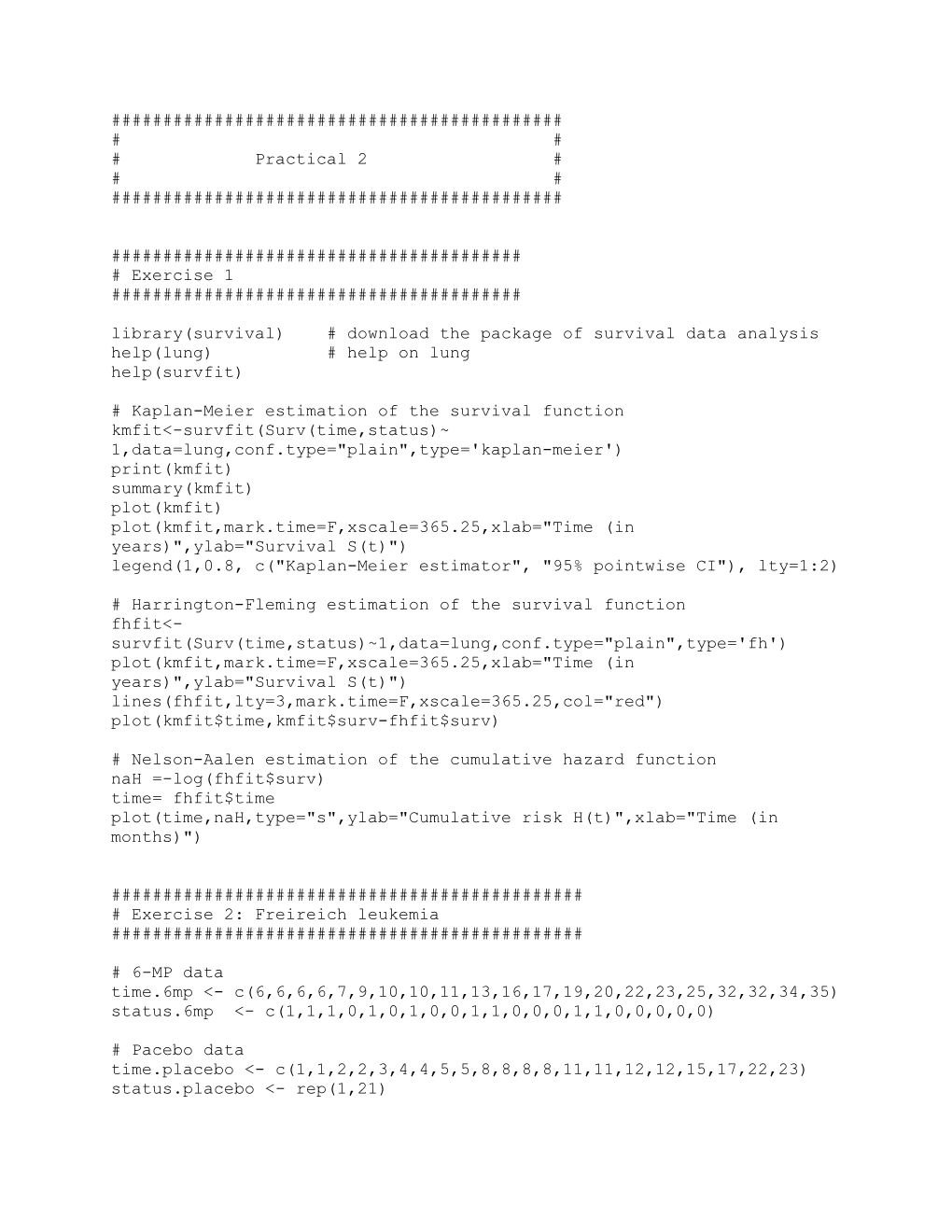############################################
# #
# Practical 2 #
# #
############################################
########################################
# Exercise 1
########################################
library(survival) # download the package of survival data analysis
help(lung) # help on lung
help(survfit)
# Kaplan-Meier estimation of the survival function
kmfit<-survfit(Surv(time,status)~ 1,data=lung,conf.type="plain",type='kaplan-meier')
print(kmfit)
summary(kmfit)
plot(kmfit)
plot(kmfit,mark.time=F,xscale=365.25,xlab="Time (in years)",ylab="Survival S(t)")
legend(1,0.8, c("Kaplan-Meier estimator", "95% pointwise CI"), lty=1:2)
# Harrington-Fleming estimation of the survival function
fhfit<-survfit(Surv(time,status)~1,data=lung,conf.type="plain",type='fh')
plot(kmfit,mark.time=F,xscale=365.25,xlab="Time (in years)",ylab="Survival S(t)")
lines(fhfit,lty=3,mark.time=F,xscale=365.25,col="red")
plot(kmfit$time,kmfit$surv-fhfit$surv)
# Nelson-Aalen estimation of the cumulative hazard function
naH =-log(fhfit$surv)
time= fhfit$time
plot(time,naH,type="s",ylab="Cumulative risk H(t)",xlab="Time (in months)")
##############################################
# Exercise 2: Freireich leukemia
##############################################
# 6-MP data
time.6mp <- c(6,6,6,6,7,9,10,10,11,13,16,17,19,20,22,23,25,32,32,34,35)
status.6mp <- c(1,1,1,0,1,0,1,0,0,1,1,0,0,0,1,1,0,0,0,0,0)
# Pacebo data
time.placebo <- c(1,1,2,2,3,4,4,5,5,8,8,8,8,11,11,12,12,15,17,22,23)
status.placebo <- rep(1,21)
# Gathered data
group <- c(rep(0,21),rep(1,21))
time <- c(time.placebo,time.6mp)
status <- c(status.placebo, status.6mp)
# Transformation of the data in "censored" data
help(Surv)
freireich <- Surv(time,status)
summary(survfit(freireich~group))
plot(survfit(freireich~group,conf.type="none"),lty=1:2,xlab="Survival time in months",ylab="Survival rate")
# Transformation of the data in "censored" data by group
freireich.placebo <- Surv(time.placebo,status.placebo)
summary(survfit(freireich.placebo)~1)
plot(survfit(freireich.placebo~1,conf.type="none"),lty=1:2,xlab="Survival time in months",ylab="Survival rate")
freireich.6mp <- Surv(time.6mp,status.6mp)
summary(survfit(freireich.6mp)~1)
plot(survfit(freireich.6mp~1,conf.type="none"),lty=1:2,xlab="Survival time in months",ylab="Survival rate")
##########################################
# Exercise 3: Hepatitis data
##########################################
# Data
time=c(1,1,1,1,4,5,7,8,10,10,12,16,16,16)
status=c(1,1,1,0,0,1,1,1,1,0,0,0,0,0)
# Kaplan-Meier estimation of the survival function
kmfit=survfit(Surv(time,status)~1,conf.type="none")
summary(kmfit)
plot(kmfit,mark.time=F,col="blue",xlab="Time (in years)",ylab="Survival S(t)")
# Harrington-Fleming estimation of the survival function
fhfit=survfit(Surv(time,status)~1,conf.type="none",type="fh")
summary(fhfit)
lines(fhfit,lty=2,mark.time=F,col="red")
legend(8,0.9, c("Kaplan-Meier", "Fleming-Harrington"), lty=1:2,col=c("blue","red"))
lambda.chap=sum(status)/sum(time)
# or adjustment of a parametric model
help(survreg)
# caution:
# survreg's scale = 1/(rweibull shape)
# survreg's intercept = log(rweibull scale) that is 1/scale with respect to ours
survreg(Surv(time,status)~1,dist="exponential")
# thus lambda.chap=exp(-intercept)
tt=seq(0,15,0.01)
expsurv=exp(-lambda*tt)
lines(tt,expsurv,lty=4,col="magenta")
#########################################
# Exercise 4: creating data
#########################################
########################################
# Simulation of n realizations of Exp(1.1)
n=100
X=rexp(n,1.1)
# Empirical cdf
plot(ecdf(X))
# Kaplan-Meier estimation of the survival function
plot(survfit(Surv(X)~1,conf.type="none",type='kaplan-meier'))
# Theoretical survival function
x=seq(0,4,0.01)
S.theo=exp(-1.1*x)
lines(x,S.theo,lty=2,col="red")
########################################
# Simulation of n censored data
C=rexp(n,1)
T=pmin(X,C)
delta=(X<=C)
nd=sum(delta)
# Whole observations (theoretical, Kaplan-Meier, MLE)
kmfit.T=survfit(Surv(T,delta)~1,type='kaplan-meier',conf.type="none")
plot(kmfit.T,mark.time=F)
lines(x,S.theo,lty=2,col="red")
lambda.mle=nd/sum(T)
S.mle=exp(-lambda.mle*x)
lines(x,S.mle,lty=2,col="magenta")
# Uncensored data (Kaplan-Meier, MLE)
T.uncensored=T[delta==1]
kmfit.T.uncensored=survfit(Surv(T.uncensored)~1,type='kaplan-meier',conf.type="none")
x=seq(0,2.5,0.01)
lines(kmfit.T.uncensored,col="blue")
lambda.mle.uncensored=nd/sum(T.uncensored)
S.mle.uncensored=exp(-lambda.mle.uncensored*x)
lines(x,S.mle.uncensored,lty=2,col="green")
########################################
# Same question with n=1000
########################################
# Comparison of the confidence intervals (plain, log, log-log)
x=seq(0,4,0.01)
par(mfrow=c(2,2))
kmfit.T.plain=survfit(Surv(T,delta)~1,type='kaplan-meier',conf.type="plain")
kmfit.T.log=survfit(Surv(T,delta)~1,type='kaplan-meier',conf.type="log")
kmfit.T.log2=survfit(Surv(T,delta)~1,type='kaplan-meier',conf.type="log-log")
plot(kmfit.T.plain,mark.time=F)
lines(x,S.theo,col="red")
title("CI plain")
plot(kmfit.T.log,mark.time=F)
lines(x,S.theo,col="red")
title("CI log")
plot(kmfit.T.log2,mark.time=F)
lines(x,S.theo,col="red")
title("CI log-log")
############################################
# #
# Practical 3 #
# #
############################################
###########################################
# Exercise 2: log-rank breast
###########################################
# 45 women 2 groups
breast=matrix(scan("breast.txt"),ncol=3,byrow=T)
breast=as.data.frame(list(duree=breast[,1],cens=breast[,2],gpe=breast[,3]))
# Kaplan-Meier estimation for both groups
kmbreast=survfit(Surv(breast$duree,breast$cens)~breast$gpe,type='kaplan-meier',conf.type="log-log")
summary(kmbreast)
plot(kmbreast,lty=3:2,xlab="Survival time",ylab="Survival")
# Logrank test
survdiff(Surv(breast$duree,breast$cens)~breast$gpe,rho=0)
# Harrington-Flemming test
survdiff(Surv(breast$duree,breast$cens)~breast$gpe,rho=1)
###################################################
# Practical 3 - Exercise 3: stratified logrank test
###################################################
# Data
time=c(8,8,13,18,23,52,63,63,70,76,180,195,210,220,365,632,700,852,1296,1296,1328,1460,1976,1990,2240)
status=c(rep(1,14),0,1,1,0,1,rep(0,6))
group=c(1,1,2,2,2,1,1,1,2,2,2,2,2,1,1,2,2,1,2,1,1,1,1,2,2) # treatment group
fctren=c(0,1,rep(0,6),rep(1,17)) # kidney function: 0 = abnormal,1= normal
# Logrank test to compare the survival function according to the kidney function
survdiff(Surv(time,status)~fctren) # S
# Plot of the survival functions according to the kifney function or the group
plot(survfit(Surv(time,status)~fctren))
plot(survfit(Surv(time,status)~group))
# Logrank test to compare the survival function of the two groups
survdiff(Surv(time,status)~group) # NS
plot(survfit(Surv(time,status)~group,subset=(fctren==1)))
plot(survfit(Surv(time,status)~group,subset=(fctren==0)))
# Logrank test to compare the survival function of the two groups stratifying on the kidney function
survdiff(Surv(time,status)~group,subset=(fctren==1)) # NS (limit)
survdiff(Surv(time,status)~group,subset=(fctren==0)) # NS
# Validation
survdiff(Surv(time,status)~group+ strata(fctren)) # becomes S !
